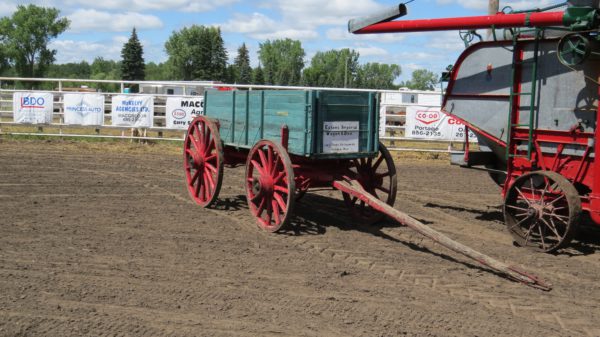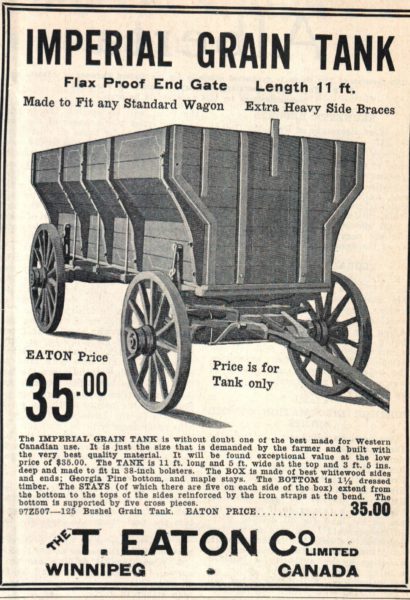
The Imperial grain wagon in the Museum’s collection was donated to the Museum by Jim and Elmer Hellegards of Holland, Manitoba.
The T. Eaton and Company sold a very wide range of articles including wagons such as the Imperial wagon seen here. Harness, simple farm implements and tools were also sold. Eatons would not have made these items but would have contracted with a manufacturer to produce the items for Eatons.
Wagons such as this one were the tandem truck of the pioneer era. The box was able to carry a wide range of articles such as grain, livestock such as pigs, lumber and was even capable of hauling water if the box was fairly new and the joints tight. If not just line the box with a canvas tarp and that would hold the water. You could remove the box and fit the wagon chassis with a rack body to hold sheaves when threshing or hold loose hay. With the addition of a “Gatling Gun” seeder to the tail gate of a grain wagon you could broadcast spread seed. Once spread the seed could be covered over by a plow set to run two inches deep. The Gatling Gun seeder broadcast the seed by means of a spinning disc driven by chain and gear box off a rear wheel. A small hopper above the disc metered the seed onto the disc. Someone had to ride in the wagon box continually filling the hopper from the wagon box while another person drove the wagon.

The standard grain box held 60 bushels of wheat. The Imperial seen here has this size of grain box. Some grain wagons were fitted with a flared box above the wheels. These boxes would hold 90 bushels. But given the poor roads of the pioneer era, 60 bushels was as much as the farmer wanted to haul particularly if the farmer had a long haul to the nearest elevator. Many areas of the Prairies, when first settled, faced a 5 or 6 day roundtrip to the nearest elevator. There would have been no amenities along the trail and the most the farmer could hope for would be to find accommodation in the barns along the way for both himself and his team. Winter posed the danger of the weather “closing” in on the farmer and team while on the trail.
Grain wagons such as this Imperial were the primary farm transport vehicle until the late 1920s when trucks both became reliable and came down in price. With the arrival of the Great Depression in 1930, horses again became more economical to operate versus internal combustion engines and wagons regained their position as the chief farm transport. By the 1930s, economic conditions improved slightly but the Second World War and the conversion of car and truck plants to war purposes resulted in wagons remaining important farm transport on the prairies. With the end of the war, economical and reliable trucks were again available. Even more importantly road construction machinery was not only economical but had gained significantly in capacity. Wagons rapidly passed out of use on the prairies.


